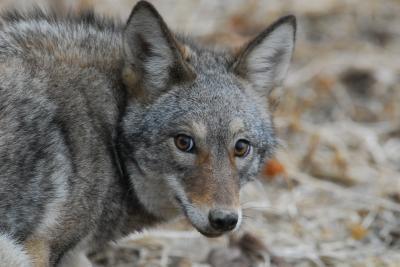If you ask rural people in the American east which is more damaging to the ecology, coyotes or deer, it may be a toss-up. But that doesn't mean it is a good idea for one to just take the other out.
In most states, deer population management also brings revenue benefits - hunting licenses and meat - but coyotes aren't hunted. They haven't been arrived that long. Coyotes -- Canis latrans -- have long inhabited the American West but are a relatively recent arrival to eastern North America, appearing first in the region in noticeable numbers in the 1970s. They have already become a significant source of deer mortality and most often prey on whitetail fawns in the earliest months of their lives.
With the range expansion of coyotes eastward, and their crossbreeding with gray wolves (Canis lupus) along the way, Eastern coyotes are larger than their Western counterparts. Many people are concerned that their predation may be adversely affecting Eastern deer populations. Recently, lawmakers in Pennsylvania proposed placing a bounty on coyotes to incentivize their destruction for the sake of deer.

Eastern coyote. Credit: Hal Korber, Pa. Game Comission
In response to those concerns, researchers initiated a study to look at deer and coyote populations from southeastern Canada through the mid-Atlantic region to the Southeast. Using published study data from throughout eastern North America that included fawn mortality, adult doe survival and reproductive rates -- and even the effects of severe winter weather on deer survival and predation -- researchers studied how deer populations responded to changes in predation and hunter harvest.
"The concern is that coyotes may be changing the established population dynamics of white-tailed deer herds through increased predation on fawns," said Duane Diefenbach, adjunct professor of wildlife ecology and leader of the Pennsylvania Cooperative Fish and Wildlife Research Unit based at Penn State. "If that's true, then deer managers need to adjust how they make harvest-management decisions, because manipulating doe harvests is typically how wildlife agencies maintain, increase or decrease deer populations."
The study showed that coyote predation -- even at the highest levels reported -- is not significant enough to cause deer populations to decline if doe harvests are reduced. In fact, in most places in North America, continued doe harvest is required to stabilize deer populations.
Diefenbach said the only place in which that might not be true is the Southeast, where wildlife managers have found the highest predation rates on fawns by coyotes. In that region, an average of only one in four fawns survives to three months of age. But that is only in combination with extremely low doe-survival rates.
"However, we couldn't find any published research on adult-doe-survival rates in the Southeast, so it is possible that if doe hunting were stopped, deer populations would stabilize despite the heavy predation."
Mortality of white-tailed deer fawns is significant across the East, Diefenbach noted. Only an average of one in two survives its first three months of life, which is when most mortality occurs. Predation by coyotes, black bears and bobcats accounts for most mortality. Regardless, the number of fawns that survive generally is adequate to sustain nearly all populations.
"Besides predators, the other major source of mortality in fawns is hunting," said Diefenbach. "Thus, reduced hunting can be used to offset mortality from natural predators. Enough fawns survive all sources of mortality that we still need to harvest antlerless deer to maintain stable deer populations. There is little evidence to date that the increase in coyote predation could create a crisis that could not be solved by wildlife managers simply responding with reductions in antlerless deer harvests."






Comments